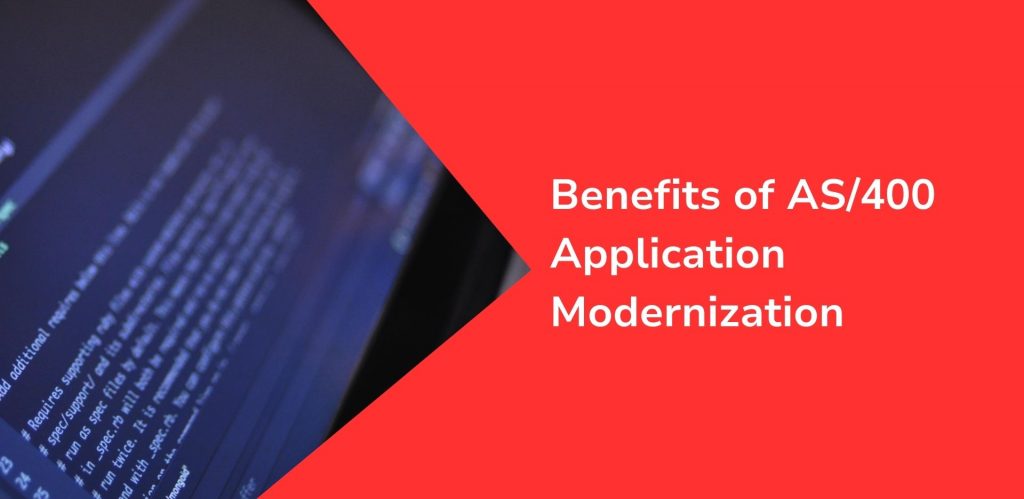
In today’s rapidly evolving technological landscape, businesses face the constant challenge of keeping their applications and systems up to date and one solution is AS400 Application Modernization.
However, as technology advances, the need to modernize these legacy applications becomes increasingly crucial.
What is AS400?
AS400, also known as IBM i, is an integrated server platform developed by IBM.
It combines robust hardware, operating system, database, and middleware into a single, cohesive system.
AS400 has been widely used by organizations across various industries for running critical business applications, managing data, and supporting business processes.
The Need for AS400 Application Modernization
Obsolescence of Legacy Systems
AS400 systems have been in use for several decades, and many businesses heavily rely on these legacy applications.
However, as technology progresses, these systems can become outdated, making it challenging to meet evolving business requirements.
Modernization helps bridge the gap between legacy systems and emerging technologies, ensuring continued functionality and compatibility.
Enhanced Scalability and Performance
Legacy AS400 applications often struggle with scalability and performance issues when faced with increasing workloads.
Modernizing these applications allows businesses to leverage the power of modern hardware, software, and cloud technologies, resulting in improved scalability, performance, and overall efficiency.
Integration with Modern Technologies
AS400 applications were primarily built to run on the traditional green-screen interface.
However, modern user interfaces, web applications, and mobile platforms have become essential for providing a seamless user experience and staying competitive in the market.
Modernization enables integration with modern technologies, ensuring compatibility and accessibility across various platforms.
Cost Reduction and Resource Optimization
Legacy systems often require specialized skills and resources to maintain and operate effectively.
By modernizing AS400 applications, businesses can reduce costs associated with legacy hardware and software, streamline operations, and optimize resource allocation.
Modernization also opens up opportunities for automation and process improvement, leading to cost savings in the long run.
Benefits of AS400 Application Modernization

Improved User Experience
Modernizing AS400 applications allows businesses to create intuitive and user-friendly interfaces, enhancing the overall user experience.
By leveraging modern design principles and user-centric approaches, organizations can improve productivity, reduce training time, and increase user satisfaction.
Increased Security and Compliance for AS400 Application Modernization
Legacy systems are often more vulnerable to security threats and may lack the necessary compliance features required in today’s regulatory environment.
AS400 application modernization helps address these concerns by implementing robust security measures, ensuring data integrity, and complying with industry standards and regulations.
Agility and Flexibility in AS400 Application Modernization
In today’s fast-paced business environment, agility and flexibility are key to adapting to changing market dynamics. Modernizing AS400 applications enables organizations to embrace agile development methodologies, leverage cloud infrastructure, and adopt scalable architectures. This agility allows businesses to respond quickly to market demands, seize new opportunities, and stay ahead of the competition.
Competitive Advantage
By modernizing AS400 applications, businesses can differentiate themselves from competitors who are still reliant on outdated systems.
Modernization empowers organizations to innovate, leverage emerging technologies, and deliver new features and services to customers faster.
This competitive advantage can lead to increased market share, customer satisfaction, and business growth.
Future-Proofing
Technology advancements are inevitable, and businesses must adapt to stay relevant.
AS400 application modernization ensures that organizations are prepared for future changes, such as evolving hardware, operating systems, and integration requirements.
By future-proofing their applications, businesses can avoid costly and disruptive migrations down the line.
Modernization Approaches for AS400 Application Modernization
There are various approaches to modernizing AS400 applications, depending on the specific needs and constraints of the business.
Here are some common modernization strategies:
Replatforming
Replatforming involves migrating AS400 applications to a more modern and scalable platform, such as cloud infrastructure or newer hardware.
This approach preserves the core functionality of the applications while taking advantage of technologies and infrastructure.
Refactoring
Refactoring focuses on improving the structure and codebase of AS400 applications without changing their core functionality.
This approach enhances maintainability, extensibility, and performance while reducing technical debt.
Rehosting
Rehosting, also known as “lift and shift,” involves moving AS400 applications to a different hosting environment, such as virtual machines or containerized platforms.
This approach offers benefits like hardware independence, cost savings, and increased scalability.
Rebuilding
Rebuilding entails redesigning and rebuilding AS400 applications using modern development frameworks, architectures, and languages.
This approach provides the most flexibility and allows organizations to take full advantage of modern technologies.
Considerations for Successful AS400 Application Modernization
To ensure a successful AS400 application modernization initiative, businesses should consider the following factors:
Comprehensive Assessment
Conduct a thorough assessment of the existing AS400 applications, including their functionality, dependencies, and performance. This assessment helps identify the areas that need improvement and determine the most suitable modernization approach.
Well-Defined Roadmap for AS400 Application Modernization
Develop a clear roadmap outlining the modernization strategy, timeline, and key milestones. This roadmap serves as a guide for the entire modernization process, ensuring that all stakeholders are aligned and objectives are met.
User-Centric Approach
Keep the end-users in mind throughout the modernization process. Involve them in the requirements gathering and design phases to understand their needs and preferences. This user-centric approach helps create applications that are intuitive, efficient, and aligned with user expectations.
Collaboration and Training
Modernization initiatives often involve cross-functional teams and external partners. Encourage collaboration, communication, and knowledge sharing among all stakeholders.
Continuous Monitoring and Optimization
Once the modernization is complete, establish a monitoring and optimization framework to continuously assess the performance, scalability, and user satisfaction of the modernized applications. Regularly evaluate and optimize the applications to keep them aligned with evolving business needs.
Conclusion
AS400 application modernization is a critical step for businesses to adapt to the changing technological landscape and unlock numerous benefits.
By modernizing their AS400 applications, organizations can enhance scalability, improve user experience, increase security, gain a competitive edge, and future-proof their systems.
However, successful modernization requires careful planning, collaboration, and a user-centric approach. Embracing modernization enables businesses to leverage emerging technologies, meet customer expectations, and thrive in today’s digital age.
Frequently Asked Questions about AS400 Application Modernization
- Is AS400 still relevant in today’s technology landscape?
Yes, AS400 is still used by many organizations for running critical applications. However, modernization is essential to keep up with evolving business needs.
- What are the risks of not modernizing AS400 applications?
Not modernizing AS400 applications can lead to compatibility issues, security vulnerabilities, limited scalability, and difficulty integrating with modern technologies.
- How long does the modernization process typically take?
The duration of the modernization process varies depending on the complexity and scope of the applications. It can range from several months to a year or more.
- Can AS400 application modernization be done incrementally?
Yes, modernization can be done incrementally, focusing on specific modules or functionalities. This approach allows businesses to manage risks and prioritize critical components.
- What is the cost associated with AS400 application modernization?
The cost of modernization depends on factors such as the scope of the project, the chosen modernization approach, and the required resources. A comprehensive assessment can help estimate the costs accurately.
Talk to our experts on understanding the benefits of AS400 Application Modernization.
Read our other blogs: How to Overcome legacy system migration challenges